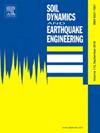刚度比例基础阻尼对风力发电机土-单桩相互作用模型的线性化
IF 4.2
2区 工程技术
Q1 ENGINEERING, GEOLOGICAL
引用次数: 0
摘要
海上风力发电机的结构设计必须考虑大量的设计负荷情况,以捕捉各种情况,包括不同环境条件下的发电、停放条件和紧急或故障条件。考虑到这些外部行为的随机性,使用特征值和安全系数或蒙特卡罗模拟的确定性分析是必要的。这个过程涉及大量的模拟,从十次到十万次不等,以实现可靠和优化的结构设计。为了降低计算复杂性,从业者可以采用低保真度模型,其中地基系统要么被忽略,要么使用线性弹性模型进行简化。然而,中到大的循环土桩横向位移会引起土的滞回行为,潜在地减轻结构和基础的振动。在初步设计阶段,一种实用的解决方案是采用刚度-比例粘性阻尼来捕捉桩土迟滞产生的阻尼。本文研究了该简化方法在大直径单桩基础上对IEA 15mw参考风力发电机组在几种运行风速和极端风速下的有效性。采用恒刚度比例阻尼模型,通过横向弹簧和旋转弹簧对桩土相互作用系统进行建模。结果表明,桩土非线性相互作用对地基产生的阻尼影响很大,不容忽视。当需要快速分析时,可以合理地使用刚度-比例粘性阻尼模型来近似风力机的结构响应。与不考虑地基阻尼的方法相比,该方法提高了计算响应的准确性,包括用于极限设计的泥线处的最大弯矩和用于疲劳分析的损伤等效载荷。本文章由计算机程序翻译,如有差异,请以英文原文为准。
Stiffness-proportional foundation damping to linearise soil-monopile interaction models for wind turbines
The structural design of offshore wind turbines must account for numerous design load cases to capture various scenarios, including power production, parked conditions, and emergency or fault conditions under different environmental conditions. Given the stochastic nature of these external actions, deterministic analyses using characteristic values and safety factors, or Monte Carlo Simulations, are necessary. This process involves a large number of simulations, ranging from ten to a hundred thousand, to achieve a reliable and optimal structural design.
To reduce computational complexity, practitioners can employ low-fidelity models where the soil-foundation system is either neglected or simplified using linear elastic models. However, medium to large cyclic soil-pile lateral displacements can induce soil hysteretic behaviour, potentially mitigating structural and foundation vibrations.
A practical solution at the preliminary design stage entails using stiffness-proportional viscous damping to capture the damping generated by the soil-pile hysteresis. This paper investigates the efficacy of this simplified approach for the IEA 15 MW reference wind turbine on a large-diameter monopile foundation subjected to several operational and extreme wind speeds. The soil-pile interaction system is modelled through lateral and rotational springs in which a constant stiffness-proportional damping model is applied.
The results indicate that the foundation damping generated by the nonlinear soil-pile interaction is significant and cannot be neglected. When fast analyses are required, the stiffness-proportional viscous damping model can be reasonably used to approximate the structural response of the wind turbine. This approach enhanced the accuracy of the computed responses, including the maximum bending moment at the mudline for ultimate limit design and damage equivalent loads for fatigue analysis, in comparison to methods that disregard foundation damping.
求助全文
通过发布文献求助,成功后即可免费获取论文全文。
去求助
来源期刊

Soil Dynamics and Earthquake Engineering
工程技术-地球科学综合
CiteScore
7.50
自引率
15.00%
发文量
446
审稿时长
8 months
期刊介绍:
The journal aims to encourage and enhance the role of mechanics and other disciplines as they relate to earthquake engineering by providing opportunities for the publication of the work of applied mathematicians, engineers and other applied scientists involved in solving problems closely related to the field of earthquake engineering and geotechnical earthquake engineering.
Emphasis is placed on new concepts and techniques, but case histories will also be published if they enhance the presentation and understanding of new technical concepts.
 求助内容:
求助内容: 应助结果提醒方式:
应助结果提醒方式:


